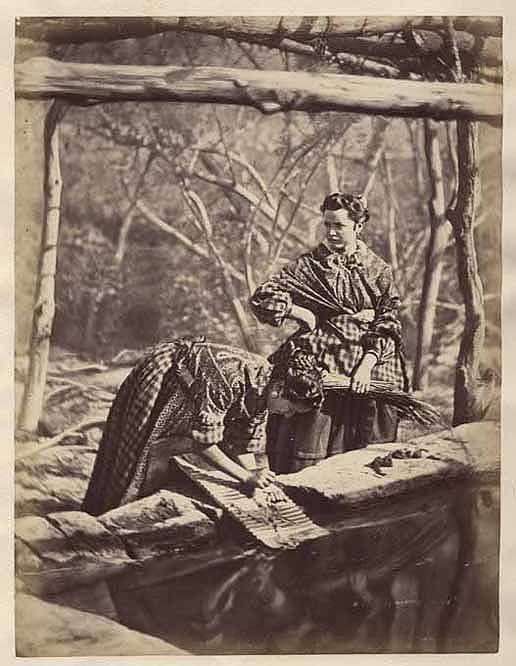Piece of the month April 2007
JEAN LAURENT, "LAUNDRESSES OF CORDOBA", 1863-72
Asunción Domeño Martínez de Morentin
Chair of Navarrese Heritage and Art
official document The Frenchman Jean Laurent y Minier (Garchizy 1816 - Madrid 1886) arrived in Spain at the beginning of the 1940s, but it was not until the following decade that he began to work as a photographer, founding a prosperous commercial business in which he had a good issue of collaborators. reference letter In the middle decades of the 19th century, Spain was a fashionable destination for foreigners in search of an exotic destination because of its culture, monuments, popular types, legendary historical past, etc. Writers, painters, engravers and also photographers came here in search of inspirational motifs that suited their romantic mentality, Andalusia being their favourite destination. It was precisely in Andalusia that the genre of genre painting had become deeply rooted in painting since the first half of the century, with painters such as José Domínguez Bécquer and Manuel Cabral y Aguado Berjerano offering a stereotypical, traditional view of these popular themes, agreement in keeping with the taste of the time.
In the second half of the 19th century, the clichéd vision of costumbrismo evolved towards more refined and realistic formulas, and it was no longer only Andalusian types that were of interest, but also those from many other Spanish regions. These popular characters are depicted in their own context, in their natural environment, and are often shown doing their daily chores. The artists - in the case of Valeriano Domínguez Bécquer - thus become witnesses of their time, aware that genre painting is an increasingly rare reality whose existence is threatened by an unstoppable process of modernisation.
sample In this context, Jean Laurent was no stranger to the mood that dominated the 19th century scene, as were other photographers such as Charles Clifford and R.P. Napper. Among Laurent's repertoires of photographs, approached with a markedly commercial sense, which include monuments, reproductions of works of art, views of cities, portraits of famous people, etc., there is also the series of popular types taken d'après nature, or, in other words, taken directly from nature. The series is a wide range of characters from different Spanish provinces - from Andalusia, but also from Valencia, Murcia and Toledo - dressed in their traditional costumes, set in their own environment.
.

Jeant Laurent, "Laundresses of Cordoba", 1863-72
Albumen paper from wet collodion negative (53'2x37'5 cm)
University of Navarra Photographic Collection (ref. 002012)
Laurent works from wet collodion negatives, a procedure which considerably reduces the time taken to exhibition, so that his models can pose more advantageously, although they still have to remain still in front of the goal. The photographer carefully chooses the setting in order to endow his images with a solid narrative that completes their meaning, which turns these photographs into veritable tableaux vivants. In The Washerwomen of Cordoba, sample does not simply show two women posing in front of the camera, but both the development of their daily activity and the setting in which the shot was taken add a formal and substantive significance, recreating an atmosphere. Laurent chooses a wide frame through which we perceive a landscape of trunks, whose intertwined forms and faded outlines serve to highlight the two main figures in the scene. In the foreground is the wash-house with its smooth mantle of softly reflecting water. In the middle ground, the washerwomen are placed in different positions, allowing the photographer to give the composition a greater sense of movement and, at the same time, to offer a more varied view of their clothing.
Laurent assembled a wide repertoire of popular and traditional types, water carriers, gypsies, peasants, shepherds and fishermen, portrayed in the countryside, on the beach or in the humble streets of towns and cities, in which the figures blend into their surroundings or take centre stage. There is no doubt that these images contributed, on the one hand, to the definition of this genre in the field of nineteenth-century photography - which was to have outstanding continuators in the following century - and, on the other, to the evolution of this thematic group in painting, as photography was to become not only an auxiliary to the artist but a true reference point for aesthetic language and plastic formulas.
bibliography:
Jean Laurent in the Municipal Museum of Madrid. Retratos, t. I: Artistas plásticos, Madrid, Museo Municipal de Madrid, 2005.
DOMEÑO MARTÍNEZ DE MORENTIN, A., "Los tipos de Laurent. La serie d'aprés nature", in De París a Cádiz, calotype and collodion, Barcelona, MNAC, 2004, pp. 118-141.
Las fotografías valencianas de J. Laurent, Valencia, Valencia City Council, 2003.
J. Laurent, un fotógrafo francés en la España del siglo XIX, Madrid, Ministerio de Education y Cultura, 1997.
La Andalucía del siglo XIX en las Fotografías de J. Laurent y Cía, Almería, Consejería de Cultura. Consejería de Obras Públicas y Transportes de la board de Andalucía, 1998.
CALVO SERRALLER, F., La imagen romántica de España. Arte y arquitectura del siglo XIX, Madrid, Alianza, 1995.
Viajeros y paisajes, Madrid, Alianza, 1988.
